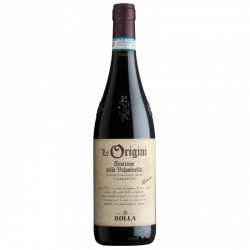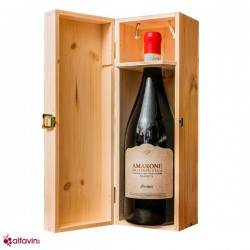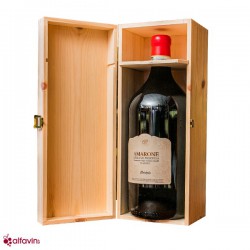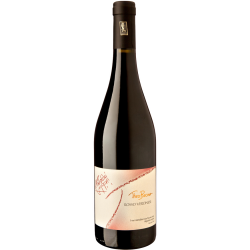All you need to know about Amarone della Valpolicella aging wines
The yields are the key to great wines. The lower the volumes of grapes extracted from a single plot, the higher the aromatic and structural quality of the grapes. This is the case with wines from the Amarone della Valpolicella DOCG.
The location of the vineyard is paramount, to say the least. The Classico sub-appellation is a geographic indicator of where the grapes come from.
The climate is cool Mediterranean in the wine regions of Veneto. The latter determines the ability of the vine to harmoniously produce quality grapes. The relatively cool climate of northeastern Italy is the result of its location south of the Austrian Alps and the presence of the largest lake in the peninsula (Lake Garda) and the largest Italian river (the Po). It gives a lot of acidity and freshness, reinforcing its drinkability. The Indian summer is long and warm and allows the perfect ripening of the berries.
The grapes most commonly used in Amarone wines are Corvina is the most emblematic and most used, it is responsible for the aromatic signature of the Valpolicella with its notes of bitter cherry. It is rather light in color and tannins with high acidity. Corvinone is more concentrated and colorful and boosts Corvina for deeper, more powerful wines. Rondinella is savory and colorful. Molinara is very acidic and low in tannin and provides freshness without heaviness. Increasingly used, Oseleta is a late variety of particular interest in the Amarone drying method.
The assembly of these varieties serves a very specific function. The latter attempts to balance both flavors (red fruit, black fruit, fresh fruit, ripe fruit) and structural elements (high/low acidity, light/powerful tannins).
The age in wood and in bottle play important roles as well. The short or extensive use of the traditional Slovenian oak cask will determine the ideal tasting window: the longer the aging, the more the woody taste will be "melted" into the wine. If the wine is subsequently aged in the bottle at the winery before marketing, this will reduce the storage time to reach full maturity.
The alcoholic titration plays a non-negligible role in the preservation of wines. Indeed, alcohol fulfills a vital antioxidant function, allowing to delay the harmful effects of too much contact with oxygen: accelerated ripening, too evolved taste, vinegarization. Amarone wines are by nature high in alcohol, between 15° and 16°, they are therefore quicker to age elegantly.
The production method is ultimately the key to understanding Amarone's quality and aging capacity. The appassimento method consists of carefully harvested bunches of grapes whole and ripe and placed on racks exposed to sun and wind. This long period of drying allows the evaporation of the water contained in the berries and the withering of the grape skins, leading to a greater concentration of the aromas and a high degree of maturity of the tannins. The juice obtained at the press is therefore extremely sweet and allows for high levels of alcohol and a significant residual sweetness, sugar plays the same role as alcohol, they both participate in protecting the wine from premature oxidation.
Conditions and aging time for an Amarone wine
Your aging wines must imperatively be stored in the most optimal conditions:
- Humidity between 60% (not too dry) and 80% (not too wet), the latter impacting the natural exchange properties of the cork stopper and leading to accelerated oxidation or the development of undesirable aromas (fungus, mold)
- Temperature between 10° (not too cold) and 14°(not too hot); the reasons are explained here.
- Total darkness otherwise the wines may develop a "light taste", i.e. a weakening of its aromatic power and the development of unpleasant aromas (garlic, cauliflower)
- Away from all regular seismic movements (earthquakes, airports, train stations) at the risk of shaking the lees or other natural elements present in the bottle too frequently and changing the taste
The automatic regulation of your wine cabinet will do the trick perfectly. A well-buried cellar can offer you excellent humidity conditions, but beware of seasonal variations and the necessary improvements to be made eventually.
The storage time is intrinsically linked to the above conditions. One or more defects in these and you will have to consider reducing more or less strongly the storage time. If, on the contrary, these are optimal, you can consider the following storage times:
- From 0 to 5 years for entry-level Amarone and the lowest alcohol wines since they will develop tertiary aromas of leather, tobacco and hunting early on. One will look for the supple and fruity side to accompany fairly simple meals.
- From 5 to 10 years for the better wines and good vintages, as the quality of the harvest and the longer aging in oak barrels will allow one to expect a slower development of the bottle aging aromas. The balance between freshness and ardor of youth and complexity and length of aging is totally bluffing at this age.
- From 10 years to 20 years for the largest wines and the largest volumes (1.50L magnums, 3L double-magnums, 5L jeroboams), with the ratio of wine quantity to neck and cork size favoring less oxidation of the wine. An old Amarone is completely saturated with very complex aromas of stewed fruits, dried herbs, animal flavors and cedar notes. The most ambitious food and wine pairings can be considered at this point.
Best vintages of Amarone
Exceptional vintages 2015, 2000, 1995
The 2015 vintage was exceptional in every way. Early season precipitation came in the form of snow in the winter and replenished the water reserves underground. The spring was rather dry and did not slow down the development of the vine. The summer season was particularly warm and allowed the grapes to ripen well (10 days ahead of time). The concentration of aromas is excellent and the tannins particularly fine. Great capacity for aging (10 to 20+ years)
The 2000 and 1995 vintages are very similar to the 2015 for their great capacity for aging. They are now medium-aged and ready to drink.
Excellent vintages 2016, 2011, 2009, 2007, 2004, 1998, 1997, 1990, 1988, 1983
The 2016 vintage is very promising. The winter was cold and dry, the spring rainy and the summer rather moderate and well ventilated, leading to a healthy and balanced harvest. The grapes were particularly colorful and aromatically powerful, with great acidity. The wines are complex and offer medium to long cellaring capacity.
The 2011, 2009, 2007 and 2004 vintages are equally excellent and can be drunk now. All other vintages have reached their peak of conservation and will need to be drunk soon.
Good vintages 2013, 2012, 2010, 2008, 2005, 1993, 1985
The 2013 and 2012 vintages are characterized by lower temperatures and offer great finesse to the tasting today. Their more delicate character will make you discover all the elegance and accuracy of the great Amarone wines at this stage of development.
The 2010 and 2008 vintages are now at the right point and will make great food and wine pairings with racy and simmered meats. All the other vintages have reached their tasting plateau and offer great food and wine pairings. All other vintages have reached their tasting plateau and offer much pleasure now.
Find all our other articles on Amarone:
What are the best Amarone wines? Alfavin.ch explains it all!
Food and wine pairing advice for the Amarone, Alfavin.ch tells you everything!
How is Amarone produced? Alfavin.ch explains it all!
Discover also our wine subscriptions to offer as gifts or for yourself.









